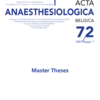Latex allergy in healthcare workers: prevalence and characteristics in Ghent University Hospital
Latex hypersensitivity; health personnel; surveys and questionnaires
Published online: Apr 21 2022
Abstract
Objective: Much research has already been conducted on the consequences of an allergy to latex in patients. Our study will focus on the consequences for healthcare workers and describe characteristics at Ghent University Hospital.
Background: Healthcare workers remain at risk of developing an allergy due to their exposure to latex since surgical latex gloves became widely spread in the ‘80s as protection against emerging infectious diseases.
Methods: After approval of the internal Ethics Committee (B.U.N.: B67Q202000Q690 – September 15 2020 – Ethics Committee of Ghent University Hospital and Ghent University) an e-survey was sent out among
healthcare workers of Ghent University Hospital. The survey consisted of 21 multiple-choice questions and was available for one month, from October 22nd 2020 to November 18th 2020. Data collection was done via SurveyMonkey and statistical analysis through SPSS Software version 26.
Results: 112 respondents answered the survey. 7.9% of respondents reported being latex allergic, 5.0% responded that they were possibly. 10.7% reacted allergically after contact with latex-containing materials and 14.3% had a
food allergy, all specified known to be have a cross allergy to latex. In general, cutaneous symptoms were dominant. 8.7% adjusted their professional activities, 6.5% limited their activities and 2.2% had to make a career change due to their allergy. 82.6% continued their latex-exposured environment without any adjustment.
Discussion and Conclusion: With 7.9% of healthcare workers at Ghent University Hospital proclaiming to be allergic to latex, our survey approaches prevalence rates among healthcare workers as described in the literature. Primary prevention of latex sensitization remains paramount and should happen through education and avoidance of unnecessary use of latex- containing materials. The exclusion of powdered gloves and the introduction of low-protein gloves have reduced the number of de novo sensitization. Additional research on the feasibility of being ‘latex-safe’ within this hospital should be done.
